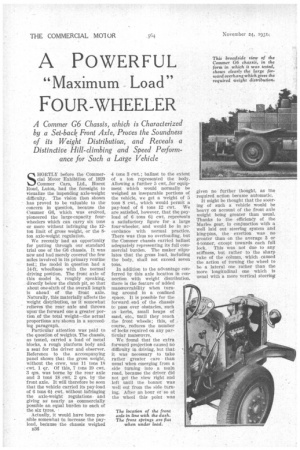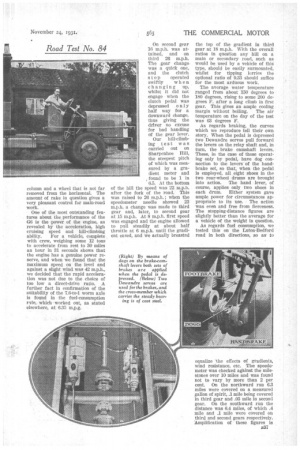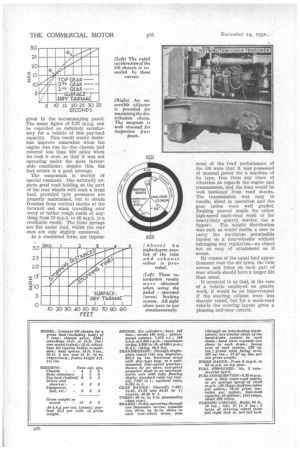A POWERFUL
Page 54

Page 55

Page 56

If you've noticed an error in this article please click here to report it so we can fix it.
6 4 Maximum Load"
FOUR-WHEELER
A Commer G6 Chassis, which is Characterized by a Set-back Front Axle, Proves the Soundness of its Weight Distribution, and Reveals a Distinctive Hill-climbing and Speed Perform
ance for Such a Large Vehicle SHORTLY before the Commercial Motor Exhibition of 1929 Commer Cars, Ltd., Bisect Road, Luton, had the foresight to 'visualize the impending axle-weight difficulty. The vision then shown has proved to be valuable to the concern in question, because the Commer G6, which was evolved, pioneered the large-capacity fourwheelers which can carry six tons or more without infringing the 12ton limit of gross weight, or the 8ton axle-weight regulation.
We recently had an opportunity for putting through our standard trial one of the G6 chassis. It was new and had merely covered the few miles involved in its primary routine test; the model in question had a 14-ft. wheelbase with the normal driving position. The front axle of this model is, roughly speaking, directly below the clutch pit, so that about one-sixth of the overall length Is ahead of the front axle. Naturally, this materially affects the weight distribution, as it somewhat relieves the rear axle and throws uponthe forward one a greater portion of the total weight—the actual proportions are shown in a succeed
ing paragraph. , Particular attention was paid to the question of weights. The chassis, as tested, carried a load of metal blocks, a rough platform body and a seat for the driver and observer. Reference to the accompanying panel shows that the gross weight, without the crew, was 11 tons 18 cwt. 1 qr. Of this, 7 tons 19 cwt. 3 qrs. was borne by the rear axle and 3 tons 18 cwt. 2 qrs. by the front axle. It will therefore be seen that the vehicle carried its pay-load of 6 tons 6i cwt. without infringing the axle-weight regulations and giving as nearly as commercially possible an equal burden to each of the six tyres.
Actually, it would have been possible somewhat to increase the payload, because the chassis weighed n36 4 tons 3 cwt.; ballast to the extent of a ton represented the body. Allowing a further 5 cwt..for equipment which would normally be weighed as inseparable portions of the vehicle, we get a weight of 5 tons 8 cwt., which would permit a pay-load of 6 tons 12 cwt. We are satisfied, however, that the payload of 6 tons 6i cwt. represents a satisfactory figure for a large four-wheeler, and would be in accordance with normal practice. There was thus no overloading, but the Commer chassis carried ballast adequately representing its full commercial burden. The maker stipulates that the gross load, including the body, shall not exceed seven tons.
In addition to the advantage conferred by this axle location in connection with weight distribution. there is the feature of added manceuvrability when turning around in a confined space. It is possible for the forward end of the chassis to pass over obstacles, such as kerbs, small heaps of sand, etc., until they reach the front wheels; this, of , course, reduces the number of locks required on any particular manceuvre.
We found that the extra forward projection caused no difficulty in driving, but that it was necessary to take rather greater care than usual when emerging from a side turning into a main road, because the driver did not get the view right and left until the bonnet was well out from the side turning. After an hour or so at the wheel this point was given no further thought, as the required action became automatic.
It might be thought that the steering of such a vehicle would be heavy on account of the front axle weight being greater than usual. Thanks to the efficiendy of the Ilrlarles gear, in conjunction with a well laid out steering system and king-pins, the exertion was no greater than on the average 3 or 4-tonner, except towards each full lock. This was not due to any stiffness, but rather to the sharp rake of the column, which caused the action of turning the wheel to be a lateral one rather than the more longitudinal one which is ingtal with a more vertical steerins column and a wheel that is not far removed from the horizontal. The amount of rake in question gives a very pleasant control for main-road work.
One of the most outstanding features about the performance of the G6 is the power of the engine, as revealed by the acceleration, high cruising speed and hill-climbing
ability. For a vehicle, complete with crew, weighing some 12 tons to accelerate front rest to ao miles an hour in 31 seconds shows that the engine has a genuine power reserve, and when we found that the maximum speed on the level and against a slight wind was 42 m.p.h., we decided that the rapid acceleration was not due to the choice of too low a direct-drive ratio. A further fact in confirmation of the suitability of the 7.6-to-1 worm axle is found in the fuel-consumption rate, which worked out, as stated elsewhere, at 6.35 m.p.g. On second gear 16 m.p.h. was attained, and on third 26 m.p.h. The gear change was a quick one, and the clutch stop operated swiftly when changing up, whilst it did not engage when the clutch pedal was depressed only half way for a downward change, thus giving the driver no excuse for bad handling of the gear lever.
Our hill-climbing test was carried out on Sharpenhoe Hill, the steepest pitch of which was measured by a gradient meter and found to be 1 in 6.5. At the bottom of the hill the speed was 22 m.p.h. after the fork of the road. This was raised to 26 m.p.h.; when the speedometer needle showed 23 m.p.h. a change was made to third gear and, later, to second gear at 15 m.p.h. At 8 m.p.h. first speed was engaged and the engine allowed to pull steadily at about half throttle at 6 m.p.h. until the gradient eased, and we actually breasted the top of the gradient in third gear at 18 m.p.h. With the overall ratios in question any bill on a main or secondary road, such as would be used by a vehicle of thiS type, should be easily surmounted, whilst for tipping lorries the optional ratio of 9.33 should suffice for the most arduous work.
The average water temperature ranged from about 150 degrees to 180 degrees, rising to some 200 degrees F. after a long climb in first gear. This gives an ample cooling margin without boiling. The air temperature on the day of the test was 63 degrees F.
As regards braking, the curves which we reproduce tell their own story. When the pedal is depressed two Dewandre servos pull forward the levers on the relay shaft and, in turn, the brake camshaft levers. These, in the case of those operating only by pedal, have dog connection to the levers of the handbrake set, so that, when the pedal is employed, all eight shoes in the two rear-wheel drums are brought into action. The hand lever, of course, applies only two shoes in each drum. Either system gave ample power for circumstances appropriate to its use. The action was even and free from fierceness. The stopping-distance figures are slightly better than the average for a vehicle of the weight in question.
As regards fuel consumption, we tested this on the Luton-Bedford road in both directions, so as to equalize the effects of gradients, wind resistance, etc. The speedometer was checked against the milestones over 10 miles and was found not to vary by more than 2 per cent. On the northward run 6.3 miles were covered on a measured gallon of spirit, .1 mile being covered in third gear and .05 mile in second gear. On the southward run the distance was 6.4 miles, of which .4 mile and .1 mile were covered on third and second gears respectively. 'Amplification of ' these figures is given in the accompanying panel. The mean figure of 6.35 m.p.g. can be regarded as definitely satisfactory for a vehicle of this pay-load capacity. This result would doubtless improve somewhat when the engine was run in—the chassis had covered less than 100 miles when we took it over, so that it was not operating under the most favourable conditions; despite this, the fuel return is a good average.
The suspension is worthy of special comment. One naturally expects good road holding on the part of the rear wheels with such a large load, provided tyre pressures are properly maintained, but to obtain freedom from vertical shocks at the forward end when travelling over wavy or rather rough roads at anything from 15 m.p.h. to 40 m.p.h. is a creditable result. The front springs are flat under load, whilst the rear ones are only slightly cambered.
In a condensed form, our impres sions of the road performance of the G6 were that it was possessed of unusual power for 11 machine of its type, free from any trace of vibration as regards the engine and transmission,: and the load would be well insulated from road shocks. The transmission was easy to handle, silent in operation and the gear ratios were well graded. Braking proved ample for either high-speed main-road work or for heavy-duty quarry, service (as a tipper). The weight distribution was such as would enable a user to carry the maximum permissible burden on a four-wheeler without infringing any regulation—an object not as easy of attainment as it seems.
By reason of the equal load apportionment over the six tyres, the twin covers and tubes on each pair, of rear wheels should have a longer life than usual.
it occurred to us that, in the case of a vehicle employed on quarry work, it would be an improvement if the steering column were less sharply raked, but for a main-road vehicle the existing layout gives a pleasing and easy control.




































































































